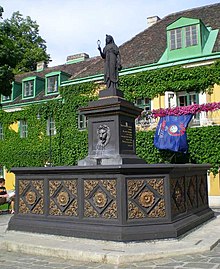Albertine aqueduct
The Albertine water pipeline was the first water pipeline project with an extensive pipeline network in the history of Vienna's water supply . It was completed in 1804 and operated until 1890.
history
The construction of the Albertine aqueduct was suggested by Archduchess Maria Christina , a daughter of Maria Theresa, who died in 1798 . The offer of her widowed husband Albert Kasimir von Sachsen-Teschen was accepted by the Lower Austrian government in December 1802 and in May 1803 the city treasurer Stephan Edler von Wohlleben was appointed site manager. At the end of 1804 the 400,000 guilders expensive building was completed.
In the Halterbachtal in Penzing , through which the Hüttelbergstraße runs today, several springs were developed, suction channels with a total length of around 4,000 fathoms and several wells were built. The well room was built between today's Otto Wagner Villa and the campsite. From there, the water was conducted by means of a double pipe to a water tower on the Penzinger hill and from there through Mariahilfer Strasse to the present-day districts of Mariahilf , Neubau and Josefstadt .
According to a government decree of September 6, 1808, the Albertinische Wasserleitung was handed over to the city administration and received by the city of Vienna from October 30, 1851 .
The water pipeline remained in operation even after the opening of the First Vienna High Spring Pipeline in 1873. First to bridge the time the pipeline network was being built and later as a reserve for the times of water shortage, which mainly occurred during the winter months. The maintenance measures were only stopped around 1890.
The former well room - a low rectangular building with a high gable roof and a door in the gable wall, which is covered with iron plates and bears the Albertine coat of arms - in Hüttelbergstrasse 30 is still preserved by MA 31 - Wiener Wasserwerke .
connections
The water was released to the population at the following locations:
- Pool near the church in Mariahilf
- Pool near the church in Gumpendorf
- Bassin in Gumpendorfer Strasse
- Fountain in Windmühlgasse
- Pool in the Stiftgasse
- Fountain in the Breite Gasse
- Run in the monastery barracks
- Pool near the Schottenfeld Church
- Pool in Neustiftgasse
- Bassin in Siebensterngasse
- Pool near the Piarist Church
The last of these fountains to have been preserved is the octagonal Isis Fountain on Albertplatz in Josefstadt. The only cast-iron fountain in the city was made in the Graf Salm'schen Eisenwerke in Blansko near Brno .
Web links
literature
- The water supply of the city of Vienna in its past and present - memorandum for the opening of the high spring water pipeline in 1873 , based on official data edited by Rudolf Stadler, Vienna, 1873, self-published by the Vienna City Council
- DEHIO Vienna - X. to XIX. and XXI. to XXIII. District , Anton Schroll & Co, Vienna, 1996, ISBN 3-7031-0693-X
- Josef Donner: To refresh you, my beloved Vienna - History of water supply from its beginnings to 1910 , Norka Verlag Dr. Norbert Kastelic, ISBN 3-85126-25-2
- Ruth Koblizek, Nicole Süssenbek: Water in every citizen's house - The drinking water supply of Vienna , MEMO Association for Historical Research , Vienna, 2003, ISBN 3-9501238-2-2


